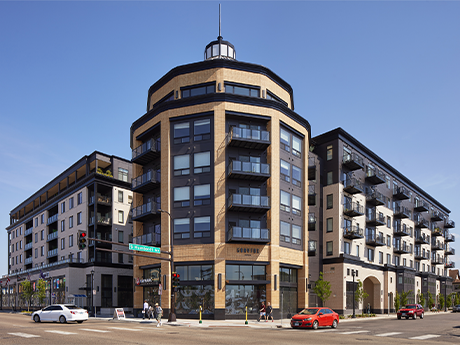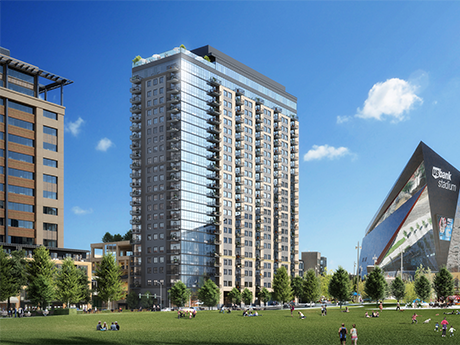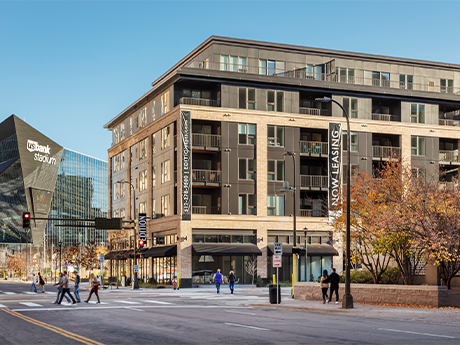The downtown Minneapolis apartment market continues to rebound from the COVID-19 pandemic’s lingering effects and the civil unrest that occurred following the murder of George Floyd in May 2020. A growing number of residents who fled to the suburbs during that tumultuous year have returned to the city.
More broadly speaking, apartment rental demand is up across the metro area, rents have hit an all-time high, and occupancy rates have remained steady in the mid-90s percentagewise. Perhaps best of all for investors is that cap rates in the Minneapolis market are higher than in the primary markets.
Abe Roberts, first vice president of investments for Marcus & Millichap, recounts how the events of 2020 upended the multifamily market in painful ways.
“The city’s lack of traffic, coupled with the unfortunate murder of George Floyd, saw an uptick in crime in the urban core,” rsays Roberts. “The growing problem not only forced tenants to relocate but also caused many landlords to sell. In some cases, we sold portfolios of multifamily buildings, which had been family owned for many decades. High-quality owners and operators who had never had any intention of selling were suddenly faced with no other option but to sell.”
In 2021, offices began to reopen in downtown Minneapolis as the worst of the pandemic had passed and both employers and employees were anxious to come out of hibernation. Pandemic restrictions were lifted in many municipalities, all the while crime figures started to fall. Once again, the short commute times and amenities of downtown life became highly desirable selling points in multifamily circles again.
“We definitely saw a flight to the suburbs following the pandemic and the civil unrest in Minneapolis,” says Nick Murnane, vice president of real estate development for The Opus Group, headquartered in suburban Minnetonka, Minnesota.
“However, with the return to the office and the re-engagement of the entertainment and restaurant districts, we have seen traffic and leasing increase in certain pockets of Minneapolis. It is very much neighborhood- specific, with the most desirable neighborhoods bouncing back quicker than others.”
Maureen Michalski, vice president of real estate development at Minneapolis- based construction and development Ryan Cos., agrees. “Yes, Minneapolis-St. Paul did experience more growth in the suburban markets during COVID. However, we have seen reversals of that trend — particularly in Minneapolis where vacancy has decreased, and rents have begun to increase again.”
Though the Minneapolis multifamily market is enjoying recovery within the city limits since 2021, the push by downtown-based companies to have workers return to the office hasn’t interrupted the growth of the suburban apartment markets.
“In certain submarkets, new product wasn’t available. Now these markets have been seeing development over the last five years,” says Michalski of the Ryan Cos.
Vital Signs, Interest Rates Rise
The average effective rent in the Minneapolis apartment market rose 6.13 percent in the fourth quarter of 2022 on a year-over-year basis and now stands at an all-time high of $1,505 per month, according to RealPage.
The occupancy rate for apartments across all classes has held relatively steady for the past four years, ranging between 94.6 percent in the fourth quarter of 2022 to as high as 96.8 percent in the fourth quarter of 2021, reports RealPage.
The sharp rise in interest rates over the past year — the 10-year Treasury yield has increased from approximately 1.6 percent at the start of 2022 to 3.8 percent as of Feb. 15 — has led to a slowdown in investment sales activity. In 2022, property and portfolio sales in the Minneapolis multifamily sector totaled $2.19 billion, down 16 percent from the prior year’s total of more than $2.6 billion, according to MSCI Real Assets. The data is based on property and portfolio sales $2.5 million and above.
Multifamily investment sales activity cooled considerably during the fourth quarter of 2022, say industry experts, a trend that is expected to continue well into 2023 due to rising borrowing costs and economic uncertainty.
“I think 2021 was a bit of an anomaly — mainly because there were some large portfolio sales that accounted for a good percentage of the $2.6 billion,” says Roberts. “That said, 2022 was off to a good start with many owners opting to sell to get ahead of rate hikes predicted throughout the year.”

Despite interest rates hitting their highest levels in years, many sellers were still expecting deals to price as before. But buyers began to struggle with financing, according to Roberts.
“As those rate hikes took effect, we saw buyers and sellers go through a pricing discovery period,” says Roberts. “Essentially, sellers were still expecting yesterday’s pricing, but buyers couldn’t make the underwriting work since lenders had increased rates, dialed back on loan-to-values and tightened lending requirements, including debt-service coverage ratios. That was the biggest roadblock for the fourth quarter of 2022, and I expect it will continue to be a hurdle in early 2023.”
On Feb. 1, the Federal Reserve raised the benchmark federal funds rate by a quarter of a point.
That was a much smaller increase than the four consecutive three-quarter-point hikes in 2022, but it marked the eighth consecutive rate hike by the Fed. Consequently, the target range for the federal funds rate has risen to between 4.5 and 4.75 percent — the highest level since 2008.
The multifamily market is already feeling the ripple effects of this series of rate hikes, according to industry professionals.
“January to May [of 2022] was a completely different world than the one we are currently in. The Fed’s interest rate hikes are working, and transaction volume has declined sharply,” says Mox Gunderson, managing director of JLL in Minneapolis.
“The challenges of inflation and interest rate hikes that have occurred in the second half of 2022 will adversely affect 2023 transactions,” says Murnane. “I believe that continued uncertainty with the future of the national economic direction into 2023 will keep some capital on the sidelines.”
Gunderson projects the volume of property and portfolio sales to wane in the near term, particularly in the first half of 2023. “Until we are able to lower interest rates or build for far less than current pricing, transaction volume will be lower.”
Development Cools Off
The prospect for continued high levels of multifamily development nationally declined significantly in the third quarter of 2022, according to the Multifamily Market Survey released by the National Association of Home Builders in December. The survey produces two separate indicators: the Multifamily Production Index (MPI) and the Multifamily Occupancy Index (MOI). During the third quarter of 2022, the MPI decreased 10 points from the prior quarter to a reading of 32.
The MPI measures builder and developer sentiment about current production conditions in the apartment market on a scale of 0 to 100. A number below 50 indicates conditions are worsening.
In Minneapolis, the construction highs of the last couple of years are proving to be a difficult act to follow. Developers added 22,327 housing units in 2021, the most since 1987, according to an annual housing report by the Met Council that analyzed building permits from across Minneapolis. Of those units, 61 percent were multifamily, a large jump from just 34 percent 10 years ago.
According to RealPage, there were 15,791 units under development in Minneapolis in December 2022, which is 5 percent of all existing inventory. For all of 2022, Minneapolis delivered 9,123 new units, accounting for 2.9 percent of all inventory.
The pace of new ground-up development has slowed, largely due to rising interest rates, but it’s not come to a halt. Ryan Cos. is currently constructing Fourth & Park, a 25-story apartment building in downtown Minneapolis. Plans call for 350 apartment units, 100 parking stalls, a sixth-floor green roof, pool deck and a community room. Completion is slated for the first quarter of 2024.
National investors are also starting to take interest. ACRES Capital Corp. provided a $19.2 million loan for the construction of Sawyer & Huck to Denver-based national investors Charles Street Development Co. in April 2022. The development will house 83 luxury units and 47 onsite covered parking spaces in the historic St. Anthony West area of Minneapolis.
Additionally, in mid-2022 Northmarq arranged $140.5 million in construction financing for the redevelopment of a two-building, multistory warehouse project in Minneapolis’ North Loop submarket for Chicago-based national developer CEDARst. Set for completion in 2024, the mixed-use project will include 358 apartments and 40,000 square feet of commercial space, as well as a parking structure.
Capital Pours Into Minneapolis Market
Many national investors are turning to opportunities in secondary markets like Minneapolis because they offer higher cap rates than primary markets. A key reason is that secondary markets tend to exhibit less market volatility, particularly during economic downturns. For example, the average cap rate in Minneapolis for 2022 was 4.9 percent compared with primary markets like New York City (4.4 percent) and Los Angeles (3.8 percent) for the same period, according to RMSCI Real Assets.

“We have seen an influx in institutional, national investment in our market, whereas the market had a much higher degree of local ownership previously,” says Dan Trebil, executive vice president and regional managing director for Northmarq. “This increased investment brings much more liquidity to the market, and with increased liquidity comes new sources of capital.”
This increased interest in Minneapolis creates a compelling case study for the direction of national and institutional investment.
In mid-2022, Greystar acquired Avana, a four-story, 456-unit property in the western suburb of Minnetonka for $126 million. In No-vember, The Connor Group, a Dayton, Ohio-based national real estate investment firm, acquired the 185-unit Dock Street Flats for an undisclosed price. Earlier in the year, KC Venture Group LLC acquired Marquee, a 231-unit property in the Loring Park neighborhood of the city for $61.6 million.
“Our market fundamentals have been consistent and healthy historically, resulting in a fairly predictable return to investors,” says Trebil in reference to this surge of investment from outside capital. “While the past several years have seen a lot of development, very little supply had been added in the decades leading up to the recent growth spurt. So, we are not oversupplied yet.”
“Development has become more challenging with the increase in interest rates, and some institutional groups indicate they will pause on investment until capital markets stabilize,” says Michalski. “While development volume may slow, we expect continued interest in the Minneapolis market as it tends to offer a more stable investment environment that is less subject to the highs and lows seen elsewhere.”
— By Kari Lloyd. This article originally appeared in the January/February issue of Midwest Multifamily & Affordable Housing Business.


